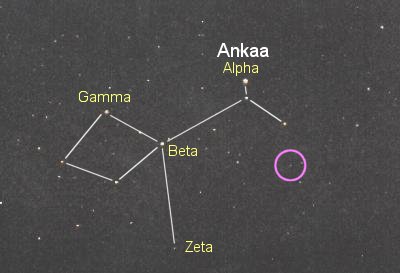 HR 6 is classed as a double star, which would make it odd as a
planet host. The companionship, however, is probably just a line-
of-sight coincidence.
HR 6 is classed as a double star, which would make it odd as a
planet host. The companionship, however, is probably just a line-
of-sight coincidence.
THE PLANET
The circle shows the location of the class G1 subgiant star HR 6,
found in the constellation Phoenix. The
planet, whose mass is at least 1.36 times that of Jupiter, orbits
with a period of 328 days at an average distance of 0.98
Astronomical Units (147 million kilometers, 91.3 million miles),
which places it much like the Earth relative to the Sun. The big
difference, other than mass, is a much higher orbital eccentricity,
which takes the planet between 1.34 and 0.62 AU, the latter 85
percent closer than Venus is to the Sun. Such a swing would make
life on Earth impossible (not to mention that life on a Jupiter-
like planet would be impossible as well).
|
 HR 6 is classed as a double star, which would make it odd as a
planet host. The companionship, however, is probably just a line-
of-sight coincidence.
HR 6 is classed as a double star, which would make it odd as a
planet host. The companionship, however, is probably just a line-
of-sight coincidence.
 HR 6 is classed as a double star, which would make it odd as a
planet host. The companionship, however, is probably just a line-
of-sight coincidence.
HR 6 is classed as a double star, which would make it odd as a
planet host. The companionship, however, is probably just a line-
of-sight coincidence.